I have a confession to make: I am a bookaholic. In a generous mood, I might call myself a ‘bibliophile’, but this self-reverential term is too polite to describe my affliction. Like a drunk, I am surrounded by the tumbling, stumbling evidence of my failure to abstain, or at the very least, moderate. I am a reader, yes, and an enthusiast, but superseding all is my need to possess. I am a collector. I cannot resist books. Not all books, of course, but even within my narrow fields of interest, the blooms are legion. I must pluck them all.
It’s just after Christmas and I’ve spent a fruitless week attempting to organize a fresh crop of books; those I bought, and those that were given to me in acts of sheer, if not well-meaning, recklessness. I am surrounded by enablers. It’s not their fault (such is the manipulative nature of addicts), and to be honest, I am so exacting in my predilections, none dare stray off a list, and most resort to gift cards. The result is the same: another stack of books. In 2013, I have acquired many such stacks of books, all vying for attention.
I have another confession to make: sometimes I don’t read them. A year may pass before I lay eyes upon a spread of illustrations, that months ago, so entranced me. At the time, it was enough to bring the book home, but the joy of adoption is soon dampened by remorse. It’s not that I regret buying the book, it’s the knowledge that I am apt to treat it badly. Neglect. Pile upon pile.
Since becoming a blogger in 2010, the situation – my addiction, has escalated. The entire world is my enabler, and my acquisitions have increased accordingly, in direct proportion to my indolence. More books, fewer reviews. Crippling guilt. It’s crazy. No one pays me for these reviews, there are no deadlines or hyperventilating bosses (or readers) breathing down my neck. And yet, I feel accountable to the books, these little gems, and to the authors and illustrators who created them. Out of sheer gratitude, I am compelled to play a role, however small, in the advocacy of their newly published work, and picture books in general. It is my pleasure and privilege to do so, but the numbers are overwhelming. Picture books may not be my only passion, but it is the one that distills my disparate interests into a single expression of joy. And lately, dread.
Some days are manageable, and I am able to focus on a single book. Other days, I despair at the never-ending lineup of new publications and dusty old favourites deserving their hour upon the stage (of my blog.) From every teetering stack, I hear their pleas. Yes, I do. Without a meticulously worded post, what are they but another book on the pile? If I were faster, my attentions less scattered, would I feel less paralyzed? Is it my aspirations that are out of whack, or my accumulations? How is it that my fellow bloggers are so prolific, many of whom have small children, while I, with no such draws on my attention, fail to post? Or, as is often the case in my life, am I just over-thinking it? However it shakes out, the bottom line is that in 2013, I did not review all the books I wanted to, and whether it makes sense or not, I feel really bad about that. The books deserve better. Now, instead of radiating joy on my bookshelves, they are little piles of judgement, which is no way to be a collector. In light of this, it seemed disingenuous to make a list of favourite books of 2013, as so few reviews were written, and some books in my possession were not even read.
To assuage my guilt – I have read, and made a list of every picture book I’ve purchased or was given to me last year. I am not going to write full reviews, at least not at this time, and ultimately, not for every book, but I cannot go forward without acknowledging the beauty that came my way in 2013. The books on this list (24 and in no particular order) are as worthy as any other book on my blog; their exclusion merely a matter of quantity, not quality. More to the point, my talent for finding beautiful books exceeds my ability to write about them (in a timely fashion.) As for 2014, fewer books, more reviews. Maybe…
 The Bear’s Song (Benjamin Chaud-Chronicle Books, 2013) One of the best books of 2013, or any year. In style, tone, and content, The Bear’s Song screams vintage, but it’s a mere three years old (originally published in France in 2011.) Harkening back to the days of Richard Scarry, Benjamin Chaud’s oversized, detail-crammed book is exactly the kind of thing I loved as a kid: busy, colourful, and terribly funny. Chaud’s elaborate drawings of Papa Bear chasing Little Bear, who in turn is chasing a bee through the country, city, and backstage at the opera are pure delight. Finding himself on stage, Papa Bear tries to get Little Bear’s attention by singing a song, but it backfires. The look on Papa Bear’s face as the audience clears the hall is priceless. The Bear’s Song is a book to linger over, to absorb, to memorize over a lazy Saturday afternoon. It makes me wish I were a kid again.
The Bear’s Song (Benjamin Chaud-Chronicle Books, 2013) One of the best books of 2013, or any year. In style, tone, and content, The Bear’s Song screams vintage, but it’s a mere three years old (originally published in France in 2011.) Harkening back to the days of Richard Scarry, Benjamin Chaud’s oversized, detail-crammed book is exactly the kind of thing I loved as a kid: busy, colourful, and terribly funny. Chaud’s elaborate drawings of Papa Bear chasing Little Bear, who in turn is chasing a bee through the country, city, and backstage at the opera are pure delight. Finding himself on stage, Papa Bear tries to get Little Bear’s attention by singing a song, but it backfires. The look on Papa Bear’s face as the audience clears the hall is priceless. The Bear’s Song is a book to linger over, to absorb, to memorize over a lazy Saturday afternoon. It makes me wish I were a kid again.
Jane, the Fox, & Me (Fanny Britt/Isabelle Arsenault-Groundwood Books, 2013) A truly magnificent book. I do hope to write a longer review, but suffice to say, this graphic novel about bullying and a young girl’s achingly fragile journey toward self-acceptance is  simply one of the most profoundly beautiful books I’ve ever read. Ridiculed at school, and ignored at home, young Helene finds salvation through books, specifically Jane Eyre. In cartoon panels and occasional full-page spreads, we learn of Helene’s chaotic life in sombre tones of grey and black. Moments of literary retreat are depicted in vibrant colour, as is the fox who shows up in a moment of grace. Isabelle Arsenault illustrated one of my favourite books of 2013 – Once Upon a Northern Night. Whether she is painting the face of a troubled girl or a snow-covered tree, Arsenault does it with exquisite sensitivity and skill. Jane, the Fox, & Me reminds me of another gut wrenching graphic novel from Quebec, Harvey (Herve Bouchard/Janice Nadeau.) Must be something about the longer format…or the province.
simply one of the most profoundly beautiful books I’ve ever read. Ridiculed at school, and ignored at home, young Helene finds salvation through books, specifically Jane Eyre. In cartoon panels and occasional full-page spreads, we learn of Helene’s chaotic life in sombre tones of grey and black. Moments of literary retreat are depicted in vibrant colour, as is the fox who shows up in a moment of grace. Isabelle Arsenault illustrated one of my favourite books of 2013 – Once Upon a Northern Night. Whether she is painting the face of a troubled girl or a snow-covered tree, Arsenault does it with exquisite sensitivity and skill. Jane, the Fox, & Me reminds me of another gut wrenching graphic novel from Quebec, Harvey (Herve Bouchard/Janice Nadeau.) Must be something about the longer format…or the province.
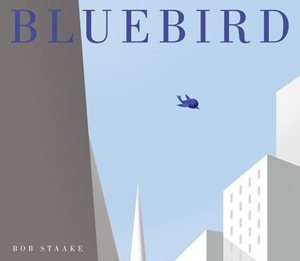 Bluebird (Bob Staake-Random House, 2013) A wordless counterpart to Jane, the Fox, & Me, Bluebird addresses the subject of bullying, loneliness, and exclusion, as well as kindness and companionship, thanks to a little bluebird who enters the life of a solitary young lad, and saves it, in more ways than one. Oblivious at first, the boy eventually notices the bird following him everywhere he goes, and they become friends. His days are filled with joy and laughter, until the bullies show up again, as they always do. Although the ending is somewhat ambiguous, what is clear is the bird sacrifices himself for the boy. Staake handles these scenes with great sensitivity, although it is undeniably bittersweet. Was it not enough that the boy found solace and companionship in nature? The computer generated illustrations are lovely, with few colours save the birds and the lightly tinted, geometric cityscape.
Bluebird (Bob Staake-Random House, 2013) A wordless counterpart to Jane, the Fox, & Me, Bluebird addresses the subject of bullying, loneliness, and exclusion, as well as kindness and companionship, thanks to a little bluebird who enters the life of a solitary young lad, and saves it, in more ways than one. Oblivious at first, the boy eventually notices the bird following him everywhere he goes, and they become friends. His days are filled with joy and laughter, until the bullies show up again, as they always do. Although the ending is somewhat ambiguous, what is clear is the bird sacrifices himself for the boy. Staake handles these scenes with great sensitivity, although it is undeniably bittersweet. Was it not enough that the boy found solace and companionship in nature? The computer generated illustrations are lovely, with few colours save the birds and the lightly tinted, geometric cityscape.
 Mattias Unfiltered: the Sketchbook Art of Mattias Adolfsson (Boom! Town, 2013) Adolfsson is something of a revelation. The Swedish artist has elevated the doodle to a fine art. With little text, the sketch-filled pages are a visual expression of the artists’ unfettered imagination. In ink and watercolour, Adolfsson’s lightly satiric and incredibly funny drawings of robots, dogs, people (often the artist himself), potatoes, elaborate architecture and Rube Goldberg-esque machinery are so staggering in their breadth, they are (for me) mentally exhausting. How could one guy be so clever, so often, and so beautifully? It’s outrageous! There are hints of Terry Gilliam and Sergio Aragonés in Adolfsson’s work, but make no mistake, he is a complete original. He is also a genius.
Mattias Unfiltered: the Sketchbook Art of Mattias Adolfsson (Boom! Town, 2013) Adolfsson is something of a revelation. The Swedish artist has elevated the doodle to a fine art. With little text, the sketch-filled pages are a visual expression of the artists’ unfettered imagination. In ink and watercolour, Adolfsson’s lightly satiric and incredibly funny drawings of robots, dogs, people (often the artist himself), potatoes, elaborate architecture and Rube Goldberg-esque machinery are so staggering in their breadth, they are (for me) mentally exhausting. How could one guy be so clever, so often, and so beautifully? It’s outrageous! There are hints of Terry Gilliam and Sergio Aragonés in Adolfsson’s work, but make no mistake, he is a complete original. He is also a genius.
The Second in Line: From the Sketchbooks of Mattias Adolfsson-Sanatorium Fortag, 2013) The pre-publication offer of an autographed book  (with personally designed button) was impossible to ignore, and so…not being one to deny myself (as I have so breathlessly outlined), I am pleased to be the owner of a beautiful, signed book. Like Mattias Unfiltered, Second in Line is a collection of Adolfsson’s most recent sketches. Wild stuff, and beautifully designed with a slipcase and poster.
(with personally designed button) was impossible to ignore, and so…not being one to deny myself (as I have so breathlessly outlined), I am pleased to be the owner of a beautiful, signed book. Like Mattias Unfiltered, Second in Line is a collection of Adolfsson’s most recent sketches. Wild stuff, and beautifully designed with a slipcase and poster.
 Backstage Cat (Harriet Ziefert/Jenni Desmond-Blue Apple Books, 2013) One of many books purchased on the spot; no thinking required. (Years of advanced picture book studies have so refined my tastes I can tell in an instant whether a book will be coming home with me.) Ostensibly a cat story, Ziefert is also celebrating theatre life, with all the backstage chaos and pre-show preparations, captured in gorgeous detail by London-based artist Jenni Desmond. Simon (the cat) is frightened up a prop tree after hearing a loud noise backstage. With help from the stagehands, and eventually, ‘his lady’, Simon is coerced down, but like all cats, Simon is a born scene stealer, once again ending up on stage later in the evening. It’s all about Simon, and Backstage Cat is all about the illustrations.
Backstage Cat (Harriet Ziefert/Jenni Desmond-Blue Apple Books, 2013) One of many books purchased on the spot; no thinking required. (Years of advanced picture book studies have so refined my tastes I can tell in an instant whether a book will be coming home with me.) Ostensibly a cat story, Ziefert is also celebrating theatre life, with all the backstage chaos and pre-show preparations, captured in gorgeous detail by London-based artist Jenni Desmond. Simon (the cat) is frightened up a prop tree after hearing a loud noise backstage. With help from the stagehands, and eventually, ‘his lady’, Simon is coerced down, but like all cats, Simon is a born scene stealer, once again ending up on stage later in the evening. It’s all about Simon, and Backstage Cat is all about the illustrations.
Rules of Summer (Shaun Tan-Lothian Children’s Books, 2013) I spirited this one out of England, as it is not yet published in North America. It is, of course, extraordinary, in the sense that there is nothing ordinary in Shaun Tan’s surrealist world. Rules of Summer is a template for those who wish to enjoy the summer, without the annoyance of giant rabbits, tornadoes, and strangely menacing steam engines. The rules are negotiated between two boys, and are entirely random: don’t leave a red sock on the clothesline, don’t be late for a parade, etc., It is like an OCD playlist in a post-apocalyptic landscape: do, or don’t do this, thus ‘preventing’ something unfortunate. The paintings are incredibly beautiful. Nightmarish, yet somehow affable. Shaun Tan has long known how to tap into the darkest corners of his imagination, but he never fails to amuse (while blowing our minds.)
 The Bird King: an Artist’s Notebook (Shaun Tan-Arthur A. Levine Books, 2010) I find artists’ notebooks endlessly fascinating, but calling the The Bird King a collection of sketches is vastly understating the issue, as many of the doodles, story ideas, observations, and stream of consciousness scribbles are themselves, works of art, able to stand side by side with the fully realized books these drawings were destined to inspire. In the introduction, Shaun Tan writes about artist’s block. Hard to imagine, given the breadth of his imagination. His solution is to just start drawing, which is what Paul Klee called ‘taking a line for a walk.’ As with all Shaun Tan books, especially one that is as spontaneous as The Bird King, you will be amazed at where this walk leads.
The Bird King: an Artist’s Notebook (Shaun Tan-Arthur A. Levine Books, 2010) I find artists’ notebooks endlessly fascinating, but calling the The Bird King a collection of sketches is vastly understating the issue, as many of the doodles, story ideas, observations, and stream of consciousness scribbles are themselves, works of art, able to stand side by side with the fully realized books these drawings were destined to inspire. In the introduction, Shaun Tan writes about artist’s block. Hard to imagine, given the breadth of his imagination. His solution is to just start drawing, which is what Paul Klee called ‘taking a line for a walk.’ As with all Shaun Tan books, especially one that is as spontaneous as The Bird King, you will be amazed at where this walk leads.
Hansel & Gretel (Brothers Grimm/Sybille Schenker-Minedition, 2013) A couple of kids about to be cannibalized by an old witch is about as grim, I mean, Grimm as you can get, but in this instance, it  is tempered by Sybille Schenker’s intensely lovely illustrations. The title is die-cut on the black cover, and the pages within are equally unusual, incorporating opaque paper inlaid with silhouettes of various scenes, blocks of patterned colours, and stark, heavily outlined characters. Design is in the forefront, and the result is a very unique and darkly engaging interpretation of a well-known fairytale.
is tempered by Sybille Schenker’s intensely lovely illustrations. The title is die-cut on the black cover, and the pages within are equally unusual, incorporating opaque paper inlaid with silhouettes of various scenes, blocks of patterned colours, and stark, heavily outlined characters. Design is in the forefront, and the result is a very unique and darkly engaging interpretation of a well-known fairytale.
 Fall Ball (Peter McCarty-Henry Holt & Company, 2013) Long-time fan of McCarty’s exquisite work. His tube-shaped characters are always amusing, but it is his meticulous application of ink and watercolour that most impresses. Although this could be said of many of the artists on this list, there is truly no one like Peter McCarty. Not a single, beautiful line is wasted. Fall Ball is a celebration of seasonal pleasures, friends, and football. There’s a wistful hint of bygone days in story of kids playing in the leaf-strewn autumnal air as the after-school light dims. One by one, they are called for dinner. Who doesn’t have a memory of that? Lovely, funny, and nostalgic (not that I ever played football.)
Fall Ball (Peter McCarty-Henry Holt & Company, 2013) Long-time fan of McCarty’s exquisite work. His tube-shaped characters are always amusing, but it is his meticulous application of ink and watercolour that most impresses. Although this could be said of many of the artists on this list, there is truly no one like Peter McCarty. Not a single, beautiful line is wasted. Fall Ball is a celebration of seasonal pleasures, friends, and football. There’s a wistful hint of bygone days in story of kids playing in the leaf-strewn autumnal air as the after-school light dims. One by one, they are called for dinner. Who doesn’t have a memory of that? Lovely, funny, and nostalgic (not that I ever played football.)
You Are Stardust (Elin Kelsey/Soyeon Kim-Owl Kids, 2012) “We  are all connected. We are all nature. We are all stardust.” An origin story encompassing the entire universe, from bits of exploded star to the single cell that is the core of all life on the planet, You are Stardust is a remarkable book. It is also subversive, in the sense that it conveys a sense of wonder without resorting to the supernatural. Soyeon Kim’s multimedia collages are interesting, but it is Kelsey’s poetic story of our interconnectedness that most captivates.
are all connected. We are all nature. We are all stardust.” An origin story encompassing the entire universe, from bits of exploded star to the single cell that is the core of all life on the planet, You are Stardust is a remarkable book. It is also subversive, in the sense that it conveys a sense of wonder without resorting to the supernatural. Soyeon Kim’s multimedia collages are interesting, but it is Kelsey’s poetic story of our interconnectedness that most captivates.
 Hello, My Name is Ruby (Philip C Stead-Roaring Brook Press, 2013) A book that flew away with my heart after just a few pages, Hello, My Name is Ruby is the gentle story of a little yellow bird and her quest to find friends. Though not always successful, Ruby is unfailingly kind, meeting a number of wondrous creatures along the way. Although she does not appear to be lost, she is unlike all the other birds and animals she meets, until one friend (an ostrich) leads Ruby to her flock, and of course she brings all her new friends with her. The breezy, pastel-coloured illustrations are very fine indeed; a perfect compliment to Stead’s simple, warm-hearted story.
Hello, My Name is Ruby (Philip C Stead-Roaring Brook Press, 2013) A book that flew away with my heart after just a few pages, Hello, My Name is Ruby is the gentle story of a little yellow bird and her quest to find friends. Though not always successful, Ruby is unfailingly kind, meeting a number of wondrous creatures along the way. Although she does not appear to be lost, she is unlike all the other birds and animals she meets, until one friend (an ostrich) leads Ruby to her flock, and of course she brings all her new friends with her. The breezy, pastel-coloured illustrations are very fine indeed; a perfect compliment to Stead’s simple, warm-hearted story.
Ike’s Incredible Ink (Brianne Farley-Candlewick Press, 2013) I am a sucker for pen & ink, so a book about the creative process starring an actual ink blot is a slam-dunk. Ike the ink blot wants to write a story, but like all true artists, ink or otherwise, Ike gets stuck, and so he cleans his home, and chats with his friends.  Procrastination plagues us all, even characters in a picture book. Eventually, Ike has an epiphany: the key to finding something to write about is having ‘your very own ink’ (effectively taking procrastination to a whole new level.) Ike sets about collecting shadows, feathers, and something from the dark side of the moon to create his personalized ink, and in the end, he has both his ink and his story. Superb illustrations and clever, perhaps autobiographical story-telling. Though the publication details do not specify whether or not Ms Farley devised her own personalized ink, the fact that this book is on the shelves suggests that she was not (permanently) foiled by the blank page. Good for us.
Procrastination plagues us all, even characters in a picture book. Eventually, Ike has an epiphany: the key to finding something to write about is having ‘your very own ink’ (effectively taking procrastination to a whole new level.) Ike sets about collecting shadows, feathers, and something from the dark side of the moon to create his personalized ink, and in the end, he has both his ink and his story. Superb illustrations and clever, perhaps autobiographical story-telling. Though the publication details do not specify whether or not Ms Farley devised her own personalized ink, the fact that this book is on the shelves suggests that she was not (permanently) foiled by the blank page. Good for us.
Henri’s Walk to Paris (Leonore Klein/Saul Bass-Universe Publishing, 2012) Originally published in 1962, Henri’s Walk to Paris is a Saul Bass 101, incorporating his signature visual sensibilities within the framework of a simple story. A boy, enamoured with Paris, decides to leave his small town and walk to his favourite city.  Though he never quite makes it, along the way he learns to appreciate the small pleasures of family life in Reboul. Bass was a famous mid-century designer whose unmistakeable squared-off style touched everything from movie title sequences (The Man With the Golden Arm, Vertigo) to product design. He only published one picture book, but it’s a knock out. To further my education, I purchased Saul Bass: A Life in Film and Design (Laurence King Publishing, 2011) which is a very comprehensive overview of his life and career. It’s a lovely book, but at 400 plus pages, I should have stuck with Henri.
Though he never quite makes it, along the way he learns to appreciate the small pleasures of family life in Reboul. Bass was a famous mid-century designer whose unmistakeable squared-off style touched everything from movie title sequences (The Man With the Golden Arm, Vertigo) to product design. He only published one picture book, but it’s a knock out. To further my education, I purchased Saul Bass: A Life in Film and Design (Laurence King Publishing, 2011) which is a very comprehensive overview of his life and career. It’s a lovely book, but at 400 plus pages, I should have stuck with Henri.
Mr Leon’s Paris (Barroux-Phoenix Yard Books, 2012) Mr Leon has been  a cabdriver in Paris for many years. Throughout his career, he has seen many different parts of Paris, and in particular, makes many friends from every possible background. A perfect setting, in other words, for some imaginative arm-chair traveling. Barroux’s illustrations are absolutely stunning; much of it drawn in pencil and pen with blocks of off-centre colour. Though I would not use this book as any sort of travel guide (unless I wanted to get lost), the art is worth the trip.
a cabdriver in Paris for many years. Throughout his career, he has seen many different parts of Paris, and in particular, makes many friends from every possible background. A perfect setting, in other words, for some imaginative arm-chair traveling. Barroux’s illustrations are absolutely stunning; much of it drawn in pencil and pen with blocks of off-centre colour. Though I would not use this book as any sort of travel guide (unless I wanted to get lost), the art is worth the trip.
The Day the Crayons Quit (Drew Daywalt/Oliver Jeffers-Philomel Books, 2013) This book has everything going for it, including the title. Any book with illustrations by Oliver Jeffers is bound to be stupendous, and a story about crayons on strike is, as far as I know, completely virgin  territory in children’s literature. Duncan just wants to colour, but when he opens his box of crayons, what he finds is a stack of letters from every crayon in the box. The list of grievances is long: Red crayon is used too much and never has Christmas & Valentine’s Day off. Pink is suffering from neglect because it’s a ‘girl’ colour, and Beige has an inferiority complex (in comparison to brown.) Who knew crayons lived such complex emotional lives? Daywalt and Jeffers (who I imagine is very familiar with crayon conflict resolution), creates a sympathetic and rather jolly group of characters. I will never look at my crayons the same way again.
territory in children’s literature. Duncan just wants to colour, but when he opens his box of crayons, what he finds is a stack of letters from every crayon in the box. The list of grievances is long: Red crayon is used too much and never has Christmas & Valentine’s Day off. Pink is suffering from neglect because it’s a ‘girl’ colour, and Beige has an inferiority complex (in comparison to brown.) Who knew crayons lived such complex emotional lives? Daywalt and Jeffers (who I imagine is very familiar with crayon conflict resolution), creates a sympathetic and rather jolly group of characters. I will never look at my crayons the same way again.
 One Gorilla: A Counting Book (Anthony Browne-Candlewick Press, 2012) One for the collection, and you must collect Anthony Browne. Like haystacks were to Monet, so primates are to Browne. In his realist-with-an-edge hands, our brothers from another mother are painted with great affection and breath-taking attention to detail. These primates are beautiful and cheeky, some mugging for the ‘camera’, others in full command of their majesty. Orangutans, chimpanzees, macaques, and Browne himself (#10) are arranged in group portraits, each page a wonder of artistic brilliance and familial love. ‘All primates. All one family.’ And one gorgeous book.
One Gorilla: A Counting Book (Anthony Browne-Candlewick Press, 2012) One for the collection, and you must collect Anthony Browne. Like haystacks were to Monet, so primates are to Browne. In his realist-with-an-edge hands, our brothers from another mother are painted with great affection and breath-taking attention to detail. These primates are beautiful and cheeky, some mugging for the ‘camera’, others in full command of their majesty. Orangutans, chimpanzees, macaques, and Browne himself (#10) are arranged in group portraits, each page a wonder of artistic brilliance and familial love. ‘All primates. All one family.’ And one gorgeous book.
The Voyage (Veronica Salinas/Camilla Engman-Groundwood Books, 2012) The Voyage is like Shaun Tan’s Arrival, but for a much younger (and less visually sophisticated) audience. What both books share is the sense of dislocation and disorientation one experiences when moving to unfamiliar surroundings. The protagonist in  this book is a duckling ‘blown so far away, he forgets who he is and where he comes from.’ Many creatures come to his aid, but it is not until he meets a duck with big feet that he is finds out who he is: “You are who you are”, answers the big-footed mallard. What a relief! Eventually, the duck learns to understand his new home. Swedish illustrator Camilla Engman’s menagerie of animals (and a fantastically cheery fly) are minimalist in style, a bit goofy, and extraordinarily likeable. The Voyage exudes warmth as it addresses complex issues like self-awareness and inclusion.
this book is a duckling ‘blown so far away, he forgets who he is and where he comes from.’ Many creatures come to his aid, but it is not until he meets a duck with big feet that he is finds out who he is: “You are who you are”, answers the big-footed mallard. What a relief! Eventually, the duck learns to understand his new home. Swedish illustrator Camilla Engman’s menagerie of animals (and a fantastically cheery fly) are minimalist in style, a bit goofy, and extraordinarily likeable. The Voyage exudes warmth as it addresses complex issues like self-awareness and inclusion.
 The Girl of the Wish Garden: a Thumbelina Story (Uma Krishnaswami/Nasrin Khosravi-Groundwood Books, 2013) Absolutely stunning. Even the story of how this book came to be is remarkable. India-born author Uma Krishnaswami adapted the words of Hans Christian Andersen to the paintings of Irainian-Canadian Nasrin Khosravi’s Farsi interpretation of Thumbelina, who in this version is called Lina. The story is familiar: a tiny girl, a languishing swallow, but in Krishnaswami’s poetic hands, a more hopeful ending. “…she ran instead into the map of her own life spread out like a carpet – all of it, birdsong and lonely fear, wind-chime and mouse-fret and illuminations of what was yet to come.” Khosravi’s illustrations soar off the page, with hints of Chagall and Gennady Spirin in the wildly imaginative and vibrantly coloured imagery. Though Khosravi died before the two could meet, it’s as if the words and art were created in unison, line by line. Magnificent.
The Girl of the Wish Garden: a Thumbelina Story (Uma Krishnaswami/Nasrin Khosravi-Groundwood Books, 2013) Absolutely stunning. Even the story of how this book came to be is remarkable. India-born author Uma Krishnaswami adapted the words of Hans Christian Andersen to the paintings of Irainian-Canadian Nasrin Khosravi’s Farsi interpretation of Thumbelina, who in this version is called Lina. The story is familiar: a tiny girl, a languishing swallow, but in Krishnaswami’s poetic hands, a more hopeful ending. “…she ran instead into the map of her own life spread out like a carpet – all of it, birdsong and lonely fear, wind-chime and mouse-fret and illuminations of what was yet to come.” Khosravi’s illustrations soar off the page, with hints of Chagall and Gennady Spirin in the wildly imaginative and vibrantly coloured imagery. Though Khosravi died before the two could meet, it’s as if the words and art were created in unison, line by line. Magnificent.
 Sowa: Meister der komischen Kunst (Verlag Antje Kunstmann, 2013) Entirely in German, but for connoisseurs of all things Sowa, there are many new illustrations, making the text somewhat irrelevant (although I do hope an English edition is eventually published.) As the title (in translation) suggests, Sowa is the master of comic art, and every illustration in this book confirms his mastery. I was very pleased (and surprised) to see the inclusion of a photograph of Sowa in his studio. There is very little about this brilliant painter in English (or anywhere, I think), and photographs are especially rare. Nice to put a face on the man who brought us Esterhazy, Little King December, and a succession of adventurous pigs and pensive dogs.
Sowa: Meister der komischen Kunst (Verlag Antje Kunstmann, 2013) Entirely in German, but for connoisseurs of all things Sowa, there are many new illustrations, making the text somewhat irrelevant (although I do hope an English edition is eventually published.) As the title (in translation) suggests, Sowa is the master of comic art, and every illustration in this book confirms his mastery. I was very pleased (and surprised) to see the inclusion of a photograph of Sowa in his studio. There is very little about this brilliant painter in English (or anywhere, I think), and photographs are especially rare. Nice to put a face on the man who brought us Esterhazy, Little King December, and a succession of adventurous pigs and pensive dogs.
The Fox in the Library (Lorenz Pauli/Kathrin Schärer -NorthSouth Books, 2013) A celebration of libraries, books, and (with the help of the former) outsmarting your enemy. A  fox follows a mouse into a library. The mouse gives the fox a book about chickens, and the fox forgets about eating the mouse. Again in the library, the newly acquired chicken (in the mouth of the fox) sees the farmer with a poultry recipe book, and the chicken offers to teach the fox how to read if the fox digs a tunnel under the chicken coop. Everyone’s happy for the price of a few books. German artist Kathrin Schärer’s lovely pastel and coloured pencil illustrations are excellent. Especially if you like foxes. And libraries.
fox follows a mouse into a library. The mouse gives the fox a book about chickens, and the fox forgets about eating the mouse. Again in the library, the newly acquired chicken (in the mouth of the fox) sees the farmer with a poultry recipe book, and the chicken offers to teach the fox how to read if the fox digs a tunnel under the chicken coop. Everyone’s happy for the price of a few books. German artist Kathrin Schärer’s lovely pastel and coloured pencil illustrations are excellent. Especially if you like foxes. And libraries.
 Once Upon a Memory (Nina Laden/Renata Liwska, Little, Brown, 2013) Ever since The Quiet Book, and especially, The Christmas Quiet Book, I have been a fan of Renata Liwska’s gentle, utterly charming illustrative style. In Once Upon a Memory, Liwska has found the perfect compliment in author Nina Laden’s sweetly evocative tale. A feather drifts in through a window, initiating a series of questions: does the feather remember it was once a bird? Does work remember it was once play? Does an island remember it was once unknown? Once Upon a Memory is thought-provoking, and it is also reverential, with a core of stillness. Be observant. Everything, everyone, has a story. Beautiful.
Once Upon a Memory (Nina Laden/Renata Liwska, Little, Brown, 2013) Ever since The Quiet Book, and especially, The Christmas Quiet Book, I have been a fan of Renata Liwska’s gentle, utterly charming illustrative style. In Once Upon a Memory, Liwska has found the perfect compliment in author Nina Laden’s sweetly evocative tale. A feather drifts in through a window, initiating a series of questions: does the feather remember it was once a bird? Does work remember it was once play? Does an island remember it was once unknown? Once Upon a Memory is thought-provoking, and it is also reverential, with a core of stillness. Be observant. Everything, everyone, has a story. Beautiful.
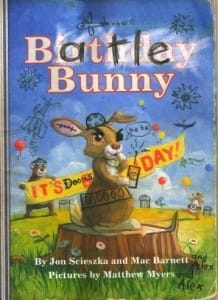 Battle Bunny (Jon Scieszka & Mac Barnett/Matthew Myers-Simon & Schuster, 2013) I will write a longer review (in the near future), simply because I love the premise of this sly and hilarious story. A young boy gets a sickly sweet present from his grandmother called the Birthday Bunny. Like many books written for children, it is cloying, condescending, and terribly unimaginative. The writing is bad. The illustrations are bad. Alexander is so bored, he creates his own story, crossing out words, adding his own, and ‘re-drawing’ the art to his own tastes. Taken at face value, the book is deliciously funny, but Scieszka, Barnett and Myers are making a much-needed point about the dreck that is endemic in children’s publishing: generic, unimaginative books that fail to engage, and in fact, fail on every level. Happily, though these books are everywhere, there are plenty of children’s books that engage, challenge, and entertain, like Birthday Bunny (the Alexander version.)
Battle Bunny (Jon Scieszka & Mac Barnett/Matthew Myers-Simon & Schuster, 2013) I will write a longer review (in the near future), simply because I love the premise of this sly and hilarious story. A young boy gets a sickly sweet present from his grandmother called the Birthday Bunny. Like many books written for children, it is cloying, condescending, and terribly unimaginative. The writing is bad. The illustrations are bad. Alexander is so bored, he creates his own story, crossing out words, adding his own, and ‘re-drawing’ the art to his own tastes. Taken at face value, the book is deliciously funny, but Scieszka, Barnett and Myers are making a much-needed point about the dreck that is endemic in children’s publishing: generic, unimaginative books that fail to engage, and in fact, fail on every level. Happily, though these books are everywhere, there are plenty of children’s books that engage, challenge, and entertain, like Birthday Bunny (the Alexander version.)
Boot & Shoe (Marla Frazee-Beach Lane Books, 2013) Absolutely wonderful on every level, from the clever 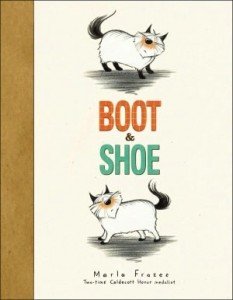 writing to the whimsical illustration. Two identical, be-whiskered pups are born into the same litter, live in the same house, and do everything together, except Boot spends his days on the back porch, and Shoe spends his on the front. Enter chaos in the form of a squirrel, getting ‘all up in’ Boot and Shoe’s business. The dogs chase the squirrel around the house until they find themselves on opposite porches, wondering where the other has gone. Boot and Shoe are confused and spend a long night without food or sleep, quietly (and rather poignantly) worrying about each other. Luckily, they meet the next morning at their favourite pee tree. Brilliant. The soft prismacolour and gouache illustrations capture both the lazily content, pre-squirrel existence of Boot and Shoe, as well their post-squirrel troubles. The whole thing seems effortless; there is not a single, wasted line or moment. In tone, voice, and illustration, Boot & Shoe is in perfect balance. I feel nothing but love (and a little jealousy) for this book.
writing to the whimsical illustration. Two identical, be-whiskered pups are born into the same litter, live in the same house, and do everything together, except Boot spends his days on the back porch, and Shoe spends his on the front. Enter chaos in the form of a squirrel, getting ‘all up in’ Boot and Shoe’s business. The dogs chase the squirrel around the house until they find themselves on opposite porches, wondering where the other has gone. Boot and Shoe are confused and spend a long night without food or sleep, quietly (and rather poignantly) worrying about each other. Luckily, they meet the next morning at their favourite pee tree. Brilliant. The soft prismacolour and gouache illustrations capture both the lazily content, pre-squirrel existence of Boot and Shoe, as well their post-squirrel troubles. The whole thing seems effortless; there is not a single, wasted line or moment. In tone, voice, and illustration, Boot & Shoe is in perfect balance. I feel nothing but love (and a little jealousy) for this book.
There may be a few more books lurking in my collection that deserve an airing, but this list represents the bulk of my 2013 acquisitions (in addition to the reviews already posted.) THANK YOU books for being beautiful, and for being in my life. Now, please stop yelling at me.

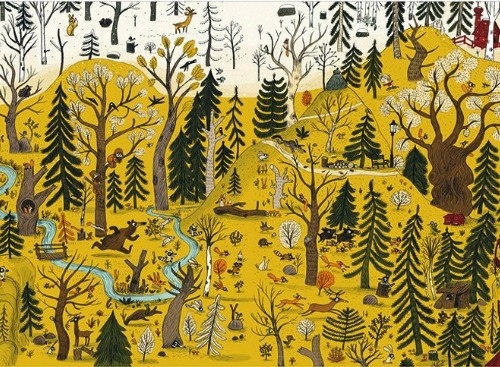
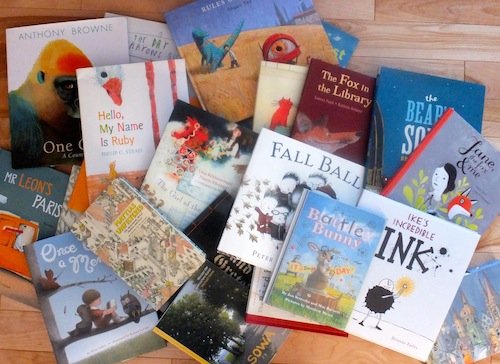


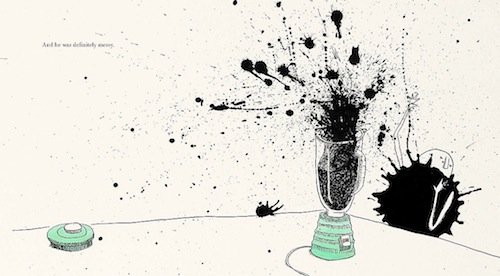
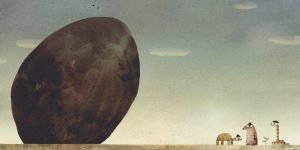
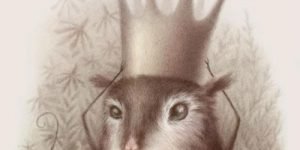
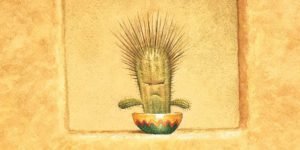
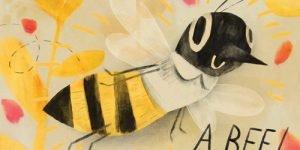

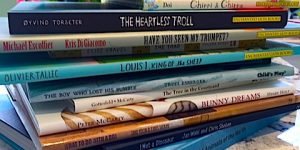

Dear dear Donna, I just so wish we lived withing visiting distance of each other and not half way round the world from each other. Reading your beautifully written opening paragraphs I recognise myself, and love what I see in you. And then perusing your list of books below…. it makes my heart sigh a little! Most of them I don’t know, which makes my finger tips fizzle…
I don’t know if I’m one of those prolific bloggers in your eyes. But I do know my blogging is what keeps me sane. It is a doorway into a world of people who care about stunningly beautiful, heart-openingly imaginative books and stories. It’s my most crucial way of feeling alive.
Thank you Donna x
The downside of doing what you love, storygirl… your passion has at times become a chore. Put your passion first and foremost, and you will feel your excitement return once again to share with us.
Yes, Zoe, you are most definitely one of those bloggers…and by that I mean, I stand in awe of your ability to write so eloquently, and frequently about books and literacy, in the middle of a busy family life. And it’s never just straight reviews…you always find some creative way of exploring the book on a deeper level. This includes your work within the community. It’s so fantastic. I’ve said this before, but one of the biggest surprises and unexpected pleasures of blogging is the connections I’ve found with people around the world. I’ve learned so much from you, and others, and because of that, my knowledge, love, and respect for children’s literature has deepened. It’s also a relief to know you can relate to this latest post in some small way. We obviously feel the same way about books, and that attachment (to books) is not without its pressures. Yeah, I wish we could go for coffee. NOW! Hopefully there’s a trip to England in my near future….
Hey Monica…the only chore is living in my brain. My passion has never wavered, but the growing stacks of books did cause stress, and stress can be paralyzing. It’s all good now. Looking forward to my next post – a book about a chicken with human arms. How great is that? The world of children’s picture books never fails to charm.
Wow, Donna, what a beautiful post, and thorough! You’ve listed off some of my favorites and a few I am now off to hunt for. Happy New Year!
You too! Thank you.
Hi Donna, A lovely post and wonderful list; I wish I could somehow get hold of these books in India.
Nice to hear from you Sathish! Yes, I would imagine some of these books would be difficult to obtain. Amazon needs to open a branch in India. You could always ask the publishers to send a copy (for review.) All the best to you!
Lovely post… is there a way to follow this website via email?? I don’t quite understand RSS feeds.